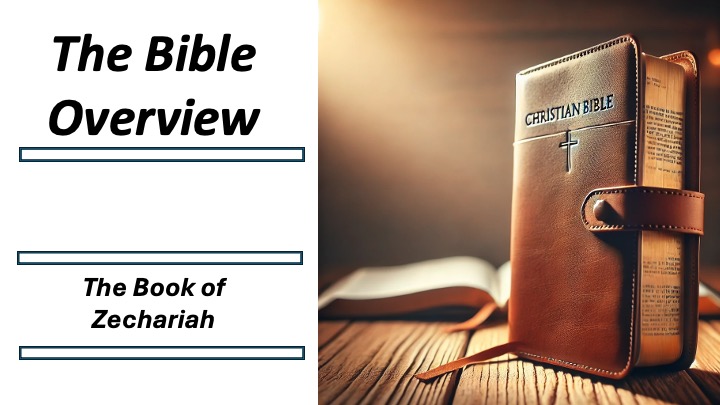Bible Overview Zechariah
Mike Ervin

Comprehensive Teaching on the Book of Zechariah
The Post-Exilic Context and Key Elements
Introduction
The Book of Zechariah, one of the twelve Minor Prophets in the Old Testament, plays a significant role in the post-exilic narrative of the Israelites. Positioned during the rebuilding of Jerusalem after the Babylonian exile, Zechariah's prophecies focus on renewal, restoration, and future hope. The book is traditionally divided into two main sections: chapters 1-8 and 9-14.
Post-Exilic Context
After the Israelites returned from Babylonian exile, they faced the monumental task of rebuilding Jerusalem and the Temple. This era was marked by both physical and spiritual renewal. Zechariah, alongside Haggai, was instrumental in encouraging the people to complete the Temple's construction and renew their covenant with God.
Main Characters
· Zechariah: The prophet and central figure who delivers God's messages.
· Joshua: The high priest, symbolizing the spiritual leadership of the people.
· Zerubbabel: The governor of Judah, representing the political leadership and a descendant of King David.
· The Angel of the Lord: A divine messenger who interprets Zechariah's visions.
Main Themes
· Restoration: The rebuilding of the Temple and the return of God's favor.
· Messianic Hope: Prophecies about the coming Messiah and the future kingdom.
· Repentance and Renewal: A call for spiritual renewal and moral integrity.
· Divine Sovereignty: God's control over history and His plans for His people.
Chapter-by-Chapter Summary
Chapters 1-3
Chapter 1: Zechariah begins with a call to repentance and a vision of horses patrolling the earth, symbolizing God's awareness and care for His people.
Chapter 2: A vision of a man with a measuring line, indicating the future expansion and protection of Jerusalem.
Chapter 3: The vision of Joshua the high priest, who is cleansed and given new garments, symbolizing the purification and restoration of the priesthood.Chapters 4-6
Chapter 4: The vision of the golden lampstand and two olive trees, representing the spiritual and political leadership of Joshua and Zerubbabel.
Chapter 5: Two visions: a flying scroll, symbolizing the removal of sin, and a woman in a basket, representing wickedness being taken away.
Chapter 6: The vision of four chariots, depicting God's judgment on the nations, and the crowning of Joshua, foreshadowing the coming Messiah.Chapters 7-8
Chapter 7: A message against empty rituals and a call for true justice and compassion.
Chapter 8: Promises of Jerusalem's future prosperity and God's renewed presence among His people.Chapters 9-11
Chapter 9: Prophecies about the coming King, who will bring peace and salvation.
Chapter 10: Promises of God's strength and restoration for Judah and Israel.
Chapter 11: The allegory of the shepherds, predicting the rejection of the true shepherd (Messiah) and the consequences of that rejection.
Chapters 12-14
Chapter 12: Prophecies of Jerusalem's final deliverance and the outpouring of God's spirit.
Chapter 13: A future cleansing from sin and idolatry, and the refining of God's people.
Chapter 14: The final chapter depicts the Day of the Lord, a time of ultimate victory and the establishment of God's eternal kingdom.Conclusion
The Book of Zechariah offers a profound message of hope and renewal for a post-exilic community. It bridges the immediate concerns of rebuilding and repentance with the future expectations of a coming Messiah and God's ultimate kingdom. Its themes of restoration, divine sovereignty, and messianic hope continue to resonate, providing timeless spiritual insights and encouragement.